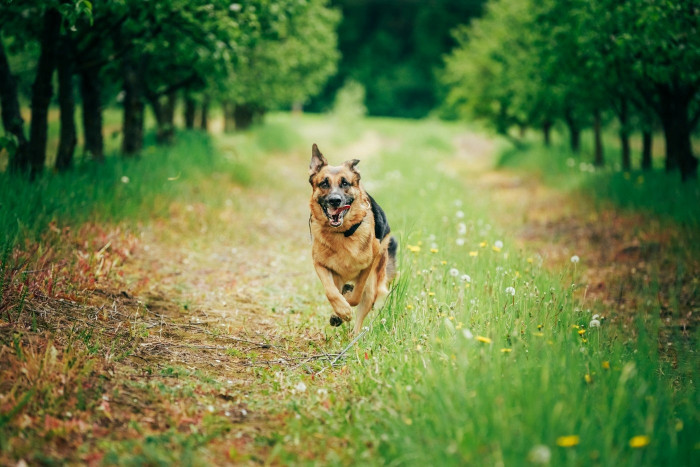The Comforting Nature of Pets

Grisha Bruev/Shutterstock
In 2004, when I was a teenager who hadn’t yet been diagnosed with granulomatosis with polyangiitis, I suffered a severe onset that required a drug-induced coma for treatment. I’d only been awake a few days when I heard a cheerful voice outside my ICU room.
“Would your patient like a visit?”
I was already grinning. On a leash beside the questioner was one of the largest dogs I’d ever seen. I recognized him as a Bernese mountain dog, with silky black fur and striking facial markings. And such enormous paws!
“Oh, absolutely,” Dad replied. “She loves dogs. Bring him in.”
I hardly heard what the humans were saying. My ears and eyes were only for my newfound friend, who wagged his fringy tail and padded over to my bed. Before anyone was able to stop him, he leaped up and settled his massive body over my legs. I enjoyed the warmth and softness of him, and couldn’t stop smiling.
The Doggie Brigade, in operation at Akron Children’s Hospital in Ohio since 1992, currently has over 40 dogs on their roster to bring joy to hospital patients. (They now even have a miniature pony!) They are just one example of an organization that fosters the magical connection between people and pets to provide therapeutic services for hospital inpatients. In an environment of discomfort and emotional trauma, the healing effects of an animal are incredible.
Since that day, I’ve owned several dogs of my own. They don’t need to be a registered service or therapy dog to inject joy into human lives. A dog is simply glad to be with you, without the emotional complexity of human relationships. There’s no second-guessing their friendship or devotion.
When my husband works long hours at the hospital and I’m working from home, the house can get quiet. That sort of atmosphere works for some, but for me, it only causes loneliness. So, it’s comforting to have another spark of life I can connect to, and even talk to, as one-sided as the conversation may be.
My current two pups, an Alaskan malamute and a German shepherd, help structure my day. When they need to be fed, it’s a welcome excuse to stand up, stretch, and walk around for a few minutes. They don’t know or care that I may not want to get off the couch — they’re hungry! And sometimes, their ignorance of my health condition makes me forget about it temporarily, too.
During seasonal extremes, it’s difficult to get outdoors as much as I should. But dogs need to go out multiple times a day, regardless of what their humans “feel” like doing. Rather than considering this a chore, I am grateful for the break in my day. If depression looms, particularly during the frigid winter, a breath of outdoor air and a glimpse of sunlight can work wonders for my mental health.
When the weather is amenable, the dogs are a great excuse to get my steps in. We walk up to three times a day, and the German shepherd runs alongside my bike for a change of pace. We explore the world together. Often, I’m having so much fun I don’t think of exercise as a duty.
A dog ensures an extra layer of protection. On weaker days, when I feel fatigued and most vulnerable, it helps knowing that there are two giant beasts to sound a booming alert if someone approaches the door.
While not everyone can have a dog, there are alternative pet options with similar benefits. Cats have a calming effect. Reptiles can be fascinating. A fish tank is a vibrant addition to any living space, providing soft background noise and colorful visuals. Animals are a reminder that we are only one part of an interconnected biological web on this planet. They help me put my disease in perspective and adopt an attitude of humility.
Then there’s the tactile sensation of softness that is comforting. That day in the hospital, the nurses had been prodding me with cold measuring instruments and taking a blood sample every few hours. I was exhausted and irritable. But feeling the Bernese’s fur under my fingers caused my mood to instantly settle — one of the brightest memories in an otherwise dark period of my life.
For those of us who can own animals, it’s an investment that pays mental and emotional returns for many years. I’m thankful to have canine friends in my life every day, but especially when the stress of a chronic illness gets to be a burden. That’s when we snap on the leash or grab a ball and head outside to bring a little happiness into our day.
***
Note: ANCA Vasculitis News is strictly a news and information website about the disease. It does not provide medical advice, diagnosis, or treatment. This content is not intended to be a substitute for professional medical advice, diagnosis, or treatment. Always seek the advice of your physician or other qualified health provider with any questions you may have regarding a medical condition. Never disregard professional medical advice or delay in seeking it because of something you have read on this website. The opinions expressed in this column are not those of ANCA Vasculitis News or its parent company, BioNews, and are intended to spark discussion about issues pertaining to ANCA vasculitis.







Comments
Angelo Vassopoulos
So true! A visit from a canine brightens up almost everyone's day! I know when my Dad was still alive and battling stage 4 lung cancer, he absolutely loved the dogs visiting every few days!!!😃
Thank you to all at Mercy hospital in Janesville WI for
all their help and support as well.